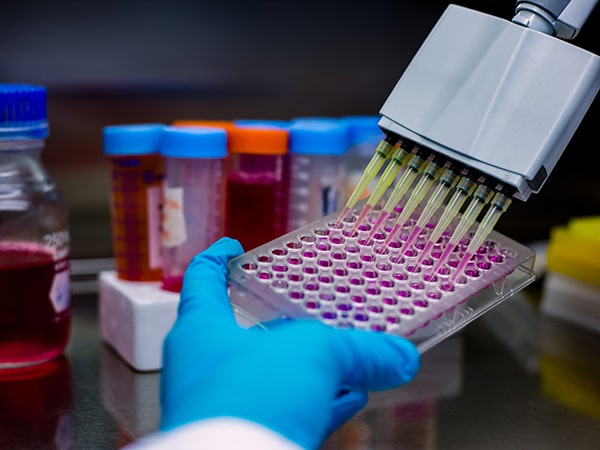From the Bench, AACR Annual Meeting 2024: CAR Tregs, Bacteria-virus Duos, and More
New technologies are providing researchers with incredible opportunities to dig deeper into the mysteries of cancer biology and devise creative approaches to combat this pervasive disease.
Each year, thousands of researchers from across the world gather at the American Association for Cancer Research (AACR) Annual Meeting to share groundbreaking scientific advances, including exciting new tools to study and treat cancer.
This quarter’s special edition of “From the Bench” highlights just a few of the innovative approaches researchers presented at the AACR Annual Meeting 2024, held April 5-10 in San Diego. Keep reading to learn about a way to turn Tregs against solid tumors, a new computational method for evaluating how large chromosome rearrangements drive cancer, a strategy to track cell-cell interactions, a bacteria-based delivery system for oncolytic viruses, and a cancer “vaccine” produced by cryotherapy.
An added bonus: the researchers explain their exciting new technologies in short video clips that you can find below.
Best Friends to Worst Enemies: Repurposing Tregs for Cancer Therapy
Not all T cells are created equal—and not all T cells have the same effect on tumors.
While effector T cells, those responsible for attacking pathogens and rogue cells, are critical components of the antitumor immune response, another type of T cell, called regulatory T cells (Tregs), exist to keep the immune system in check. Their presence in solid tumors typically means the Tregs are helping the tumor by dampening the immune response.
Tregs excel at penetrating the dense tumor microenvironment around solid tumors, whereas effector T cells, including engineered T cells used in chimeric antigen receptor (CAR) T therapy, often cannot. Leonardo Ramos Ferreira, PhD, an assistant professor at the Medical University of South Carolina, and colleagues sought to combine the tumor-invading powers of Tregs with the antitumor toxicity of effector T cells by engineering human Tregs to express CARs.
“My research focuses on turning one of cancer’s best friends into one of its worst enemies,” Ferreira said.
The researchers showed that CAR activation in Tregs spurred the production of inflammatory cytokines characteristic of effector T cells; the in vitro, CAR Tregs were able to kill cancer cells while retaining the expression of chemokines that typically allow them to infiltrate the tumor microenvironment. In an immune-compromised mouse model, treatment with CAR Tregs inhibited the growth of both blood cancers and solid tumors. Ferreira and colleagues are now repeating these studies in immunocompetent mouse models to better mimic how they might work in patients, and Ferreira expressed hope that the CAR Tregs could potentially “open the door” to allow other cancer-fighting immune cells into the tumor.
Baking BISCUTs: Finding Cancer Drivers in Abnormal Chromosomes
Gains and losses of large chromosome chunks is a common feature of cancer, but such massive insertions and deletions can be difficult to study. When an entire chromosome arm is repeatedly doubled or missing, it can be hard to tell which gene(s) are being selected for.
“For some of these events, we have guesses as to what tumor suppressors or oncogenes are driving them, but for many of them, we actually don’t know,” said Alison Taylor, PhD, an assistant professor of pathology and cell biology in the Herbert Irving Comprehensive Cancer Center at Columbia University.
Taylor and colleagues developed a machine learning algorithm called Breakpoint Identification of Significant Cancer Undiscovered Targets (BISCUT) that uses publicly available genomic data to assess common chromosome break points within and between various cancer types. If a chromosome arm does not confer a selective pressure, researchers would expect break points to be distributed evenly across the arm. If a gene affects cancer cell growth, break points may be concentrated before or after the gene depending on whether the cell wants to delete or preserve it. By looking for the locus where the proportion of observed break points differs most from what is expected, researchers can find the driver genes, Taylor said.
Taylor and colleagues used BISCUT to analyze the chromosome arm 8p, frequently lost in a variety of epithelial tumor types. They observed a peak near the Werner helicase gene (WRN) and confirmed that knocking out WRN in vitro decreased cancer cell death.
“With this [algorithm], we can understand why these changes are important in cancer and how we can target them,” Taylor said.
The Best of Both Microbes: Using Bacteria to Deliver Oncolytic Viruses
Researchers have long tried to use viruses to kill cancer cells by exploiting viruses’ natural propensity to replicate in cells with dysregulated cell cycle checkpoints—a characteristic feature of cancer. The trouble with these oncolytic viruses, however, is that the body’s immune system often clears them before they’ve had a chance to infect cancer cells, and viral infection often requires specific cellular receptors.
But an innovative approach that combines the tumor-colonizing ability of bacteria with the cell-killing ability of viruses may help overcome these obstacles, according to Jonathan Pabón, PhD, a medical student in Columbia University’s MD/PhD program.
As part of his graduate thesis research, Pabón developed a modified form of Salmonella in which part of the bacterial genome is replaced with the full-length RNA genome of Senecavirus A. The modified Salmonella successfully delivered the viral genome into cancer cells—bypassing the need for a viral-specific receptor—and led to the production of viral particles and death of the infected cancer cells. In mice, the bacteria-virus duo induced complete tumor regression.
“We’re pairing bacteria’s ability to grow well inside tumors with the very potent cytopathic effects of oncolytic viruses into one vector,” Pabón said. “[By] having a system that’s based both on bacteria and viruses, we’ve created a system that overcomes the shortcomings associated with each individual microbe.”
As an added regulatory feature, the researchers integrated a mechanism that spatially restricted the virus, thereby preventing widespread viral infection. This was accomplished by making viral production dependent on an enzyme from the bacteria, rendering the virus noninfectious in cells that were not coinfected with the Salmonella vector.
Passing the Baton: Relay System Tracks Cellular Interactions
Much like a relay runner passes the baton once she nears her teammate, cells often pass molecules to neighboring cells. A new approach—aptly named “Relay”—takes advantage of this natural cellular function to study cell-cell interactions.
The method, developed by Neil Tay, PhD, a postdoctoral scholar at the University of California, San Francisco, identifies which cells have interacted with one another by tracking the transfer of synthetic RNA barcodes from one cell to another. Unlike existing cell-cell interaction assays, Relay can be paired with high-throughput sequencing-based technologies, such as CRISPR and RNA sequencing.
Tay and colleagues used Relay to study interactions between cancer cells and T cells, which identified antigen-specific interactions as well as less potent interactions that occurred during antigen sampling. The researchers paired Relay with a CRISPR screen to examine how manipulation of various genes impacted the interactions between cancer cells and T cells. They also paired Relay with single-cell RNA sequencing to determine how interactions between cancer cells and T cells affected transcriptional signatures in each cell type.
“Relay will allow us to study cell-cell interactions in a much higher throughput than is currently possible,” said Tay. “Hopefully, this will allow us to better understand how cancer cells and immune cells interact and how anticancer immune responses form.”
Freezing Out Cancers: Using Cryotherapy to Enhance Immunotherapy
Prostate cancers are often described as immunologically “cold,” but what if a different kind of cold—the temperature kind—could turn these tumors “hot” and make them susceptible to immunotherapies?

This was the thinking behind a new approach presented by Charles Link, MD, an adjunct professor at Lankenau Institute for Medical Research, part of Main Line Health, and a cofounder and executive chairman of Syncromune.
Link and colleagues developed a therapy, called SYNC-T, in which a cold-temperature probe is inserted directly into the prostate tumor, akin to the method routinely used to conduct prostate biopsies. The cold-temperature probe freezes and ruptures a portion of the tumor, releasing immune-stimulating proteins unique to the tumor. In essence, the method generates a personalized in situ neoantigen cancer vaccine that serves to activate the immune system, Link explained.
Immediately following the cold-driven rupture of cancer cells, an investigational immunotherapy cocktail called SV-102 is infused into the lysed portion of the tumor, which helps the “vaccine-induced” immune cells mount an antitumor immune response.
In a phase I clinical trial, 11 of 13 evaluable patients with metastatic prostate cancer experienced objective responses to SYNC-T, and the remaining two patients experienced stable disease. Mild to moderate adverse events were observed in six patients.
“Our results indicate that SYNC-T is associated with a high response rate without generating severe toxicity in this initial group of patients,” Link summarized. “Further, this approach uses standard procedures already employed by urologists and radiologists, which means the treatment could potentially be rapidly adopted by treating physicians.”



